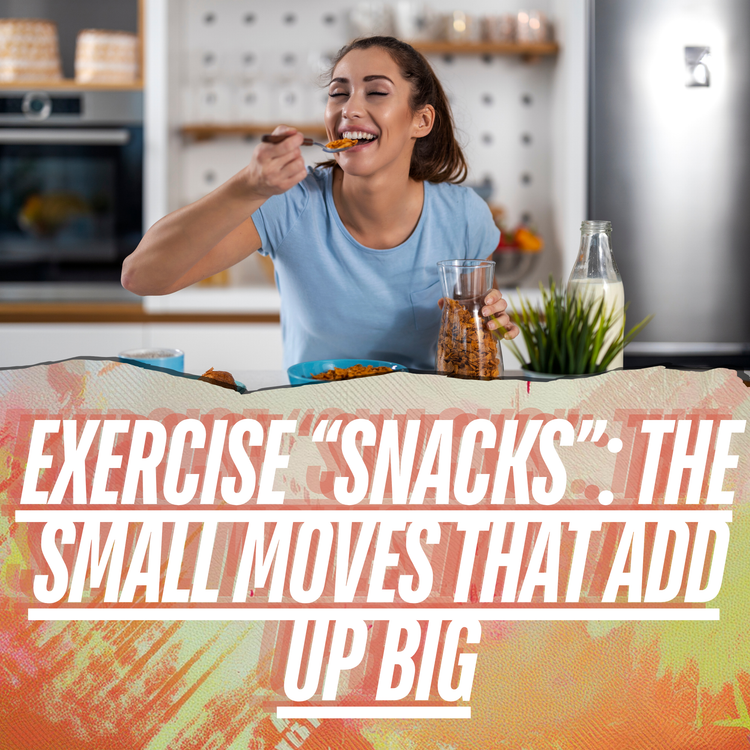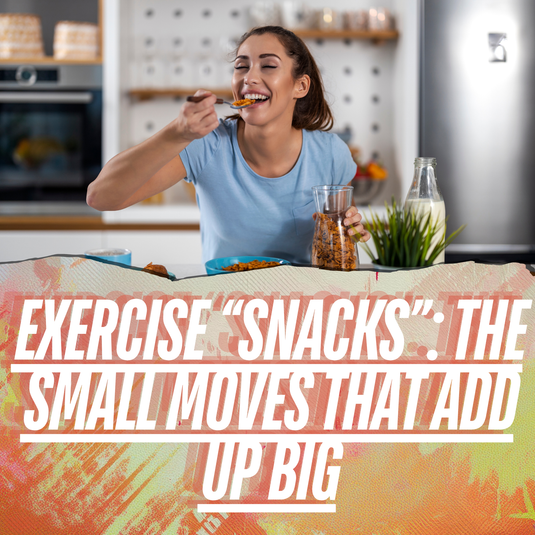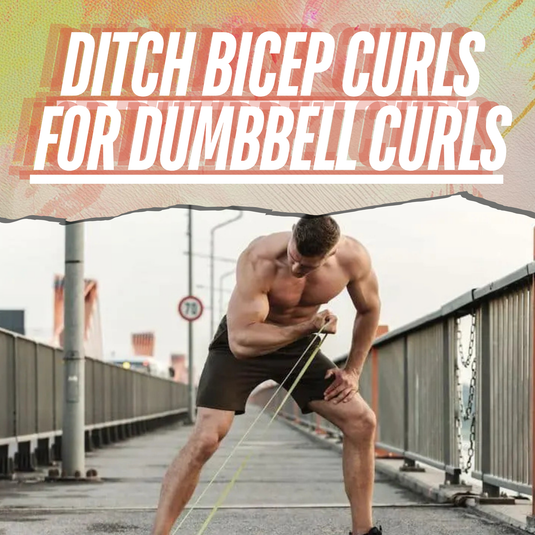Exercise “Snacks” (a.k.a. Snacktivity): The Small Moves That Add Up Big

Exercise Snacks (a.k.a. Snacktivity): The Small Moves That Add Up Big
“Exercise snacks,” also known as Snacktivity, are proving to be a simple and time-saving way to boost fitness and break long periods of sitting. They’re especially helpful for people who find regular workouts hard to fit in. The concept is promising, but the science is still catching up. How intense should these mini-workouts be? How often should you do them? What works best for different people? Researchers are still exploring these questions to understand the full impact and help people stick with them in everyday life.
Does Snacktivity Really Work?
Can short bursts of activity truly make a difference to your health and fitness, especially if you don’t have time or motivation for long workouts? Research suggests that even a few minutes of brisk effort several times a day can improve heart fitness, energy levels, and mood. The principle is simple: move more, in small, intentional chunks. Here’s what experts and research reveal about what works, what doesn’t, and how to make snacktivity a lasting habit.
What Are “Exercise Snacks”?
Think of them as bite-sized workouts spread throughout your day—quick sets of squats before lunch, a one-minute stair climb after coffee, or a fast-paced walk around the block before picking up the kids. Unlike casual movement, exercise snacks are intentional. Most last anywhere from 30 seconds to 3 minutes.
Why is this trend catching on? Modern life is busy. Carving out a 45-minute workout can feel impossible. Snacktivity fits movement into real life without special clothes, equipment, or long gym sessions. For more tips on making fitness fit your lifestyle, check out our Functional Training Guide.
Why Everyone’s Talking About Snacktivity
Recent research shows that short bouts of activity can add up to meaningful fitness gains. A 2025 review found that breaking up your day with small exercise “snacks” improves heart health and overall fitness, especially for those who are usually sedentary. Source
Other studies indicate improvements in aerobic capacity and increased energy levels for people who perform multiple short bouts of activity per day. Source
Compliance rates are high—likely because mini workouts feel less overwhelming than full-length sessions. The takeaway? Small efforts count. You don’t need an hour to make progress—just move with purpose a few times a day.
What Most People Don’t Know About Exercise Snacks
1. Not All “Snacks” Are Created Equal
Some studies use very short, high-intensity bursts (like sprinting up stairs), while others use low-intensity movements (like light walking). Because definitions vary, results vary. Generally, the bigger the effort, the more benefit you’ll likely see. Source
2. Most Research Is Small and Short
Many studies only tested snacktivity for a few weeks with limited participants. Early signs are positive, but longer, larger studies are needed to understand how well this works in real life and for different populations.
3. Real-Life Adoption Is the Hard Part
Climbing stairs in a lab is different from remembering to do it daily at work. Snacktivity works best when you create simple cues and routines, like a set of squats every time you make coffee.
4. The “Right Dose” Is Still a Mystery
How many snacks per day? How intense? How long? No one-size-fits-all formula exists yet. Most people benefit from 2–4 mini workouts per day, 1–3 minutes each, at an effort that feels “hard but doable.”
Why These Tiny Workouts Actually Work
- It wakes up your metabolism: Each movement burns extra energy and helps regulate blood sugar, giving your metabolism a quick boost.
- It boosts your heart and lungs: Short bursts get your heart pumping and lungs working efficiently, like a mini cardiovascular tune-up.
- It strengthens your muscles: Quick sets of squats, lunges, or push-ups add up, toning and strengthening muscles over time.
- It breaks up sitting time: Sitting for long periods slows circulation and increases health risks. Quick movement snacks every hour or two help keep your body active.
Think of it like brushing your teeth: one brush won’t transform your smile, but doing it consistently keeps your system healthy.
What We’ve Learned (and What We Haven’t)
What We Know
- Snacktivity improves cardiovascular fitness for inactive individuals.
- It’s safe, easy, and requires little to no equipment.
- People often find it more enjoyable than traditional long workouts.
- It helps break up sedentary time, benefiting metabolic and mental health.
What’s Still Unclear
- How intense should each snack be?
- How long do benefits last if you stop?
- What’s the ideal “dose” — how many snacks per day and per week?
- How does it work for those with medical conditions, joint pain, or limited mobility?
Expert Insights: What’s Often Overlooked
- Your first 30 seconds matter most: The initial few seconds of activity trigger cellular benefits similar to longer workouts.
- Spacing vs. clustering: Spaced mini workouts may keep your metabolism elevated longer. Source
- Individual differences: Sedentary, older adults or those with insulin resistance may see bigger benefits than already fit individuals.
- Habit cues are key: Visual reminders or linking movement to existing routines helps make snacktivity automatic.
How to Build Your Own Snacktivity Plan
1. Start Small
Begin with 2–3 short bursts of activity, each lasting about a minute. Think of them as mini wake-up calls for your body.
2. Use Your Environment
- Take stairs quickly when you can.
- Do calf raises or wall sits while brushing your teeth.
- March in place between meetings.
- Keep a resistance band near your couch for mini strength breaks. (Learn more)
3. Mix It Up
Alternate upper- and lower-body moves. Example schedule:
- Morning: 1 minute of squats while coffee brews
- Lunch: 1 minute of brisk stair climbing
- Afternoon: 1 minute of push-ups or wall presses
- Evening: 1 minute of dancing or jogging in place
4. Listen to Your Body
Activities should be challenging but not painful. If shortness of breath is manageable, you’re in the right zone. For joint pain or health conditions, use lower-impact options like walking or mobility exercises.
5. Track Your Progress
Use your phone, a checklist app, or sticky notes to track each “exercise snack.” Every small effort counts toward your fitness goals.
Snacktivity for Different Lifestyles
At work: Stand up every 90 minutes, stretch, roll your shoulders, or add calf raises. Short stair sessions work too.
At home: Squats or lunges while waiting for the microwave, push-ups during ad breaks, or a quick plank. (More home exercises)
Parents: Turn playtime into mini workouts—dance breaks, fast tag games, or active play with kids.
Older adults: Chair rises, light marching, or resistance band pulls. Short, safe movements work wonders. (Learn more)
What’s Next for Snacktivity Science
Experts call for better studies to understand:
- Standardizing snack length, intensity, and frequency
- Comparing snacktivity to traditional workouts long-term
- Helping people stick with it for life
- Effects on blood pressure, cholesterol, or weight management
In other words, snacktivity is promising but still new. It’s not magic—just movement made doable.
Final Thoughts: The Power of Small Moves
Being busy often trumps being healthy in modern life. Exercise snacks allow people to stay active despite hectic schedules. You don’t need an hour at the gym—just small moments and the willingness to move.
Snacktivity is the fitness version of “a little goes a long way.” Each short burst builds up over time. One snack won’t transform you, but hundreds over weeks and months absolutely can.
In the end, the best exercise is the one you’ll actually do. If big workouts feel out of reach, start small, snack often, and move with intention. Your heart, muscles, and mind will thank you—one burst at a time.




